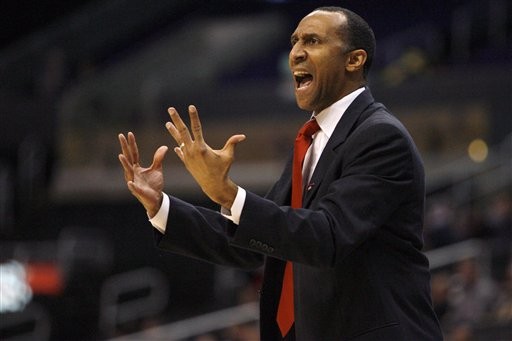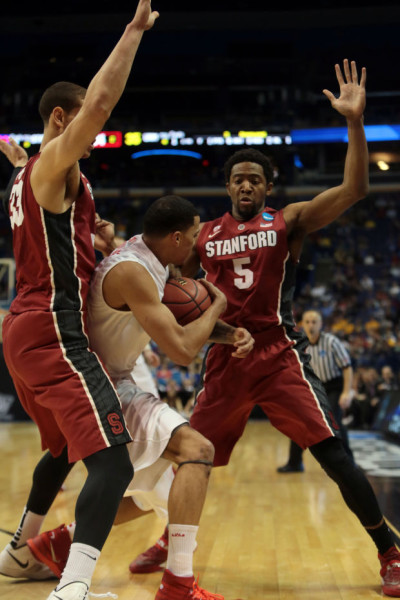Johnny Dawkins’ Road Map Gets Stanford to the Sweet Sixteen
Posted by Andrew Murawa (@amurawa) on March 27th, 2014Andrew Murawa (@amurawa) is the NCAA Tournament’s West Region correspondent, which begins Thursday night at Honda Center in Anaheim with Baylor vs. Wisconsin followed by San Diego State vs. Arizona. Make sure to also follow @RTCWestRegion for news and analysis from Anaheim throughout the week.
Last March, Stanford athletic director Bernard Muir had a telephone conversation with Jeff Faraudo of The Bay Area News Group in which he basically recounted laying down an ultimatum for head coach Johnny Dawkins: Make the NCAA Tournament in 2013-14, or it is time to move on. “We want to be playing for a [conference] championship. We think we have the caliber of kids who can do that,” Muir told Faraudo. “And we want to play in the NCAA [Tournament]. The goal has always been and will not change: We want to play well into March on the grand stage of March Madness. There’s a clear expectation that we can do that next year.” For a coach who had missed the NCAA Tournament in his previous five years in the position, and with roughly the same team expected to return, it seemed like quite a challenge at the time. And from there, the challenge grew even bigger.

Despite Four Players Lost To Season-Ending Injury, Johnny Dawkins Has Stanford Still Playing. (Danny Moloshok/AP)
In July, a torn ACL for senior forward Andy Brown – his fourth such injury in a span of just over four years – ended his Stanford playing career. In October, it was announced that sophomore guard Christian Sanders would miss the season with a hip injury. At roughly the same time, sophomore forward Rosco Allen was said to be out six to eight weeks with a shin injury; those six to eight weeks turned into a lost season, as Allen played just seven minutes all year. Then, the coup de grace came in early December when a dislocated right shoulder would keep senior point guard Aaron Bright out for the remainder of the season. Before conference play even rolled around, four key players, each of whom would have had a role on this Stanford basketball team, were lost for the season.
Well, now is the time where we might as well jump ahead to the happy point in the story: As you know, Stanford not only made the NCAA Tournament, they’re getting ready to play Dayton tonight in the Sweet Sixteen for an opportunity to advance to the Elite Eight. We all saw that coming, right? Still, Dawkins does not seem to have won over his many critics, but here are some of the different things that Dawkins has done that deserve to be credited. First and foremost, his team’s defensive improvement needs to be recognized. While the points per possession that Stanford allowed last year was slightly less, we need to take into account that partially due to changes in officiating enforcement, points per possession across the country are up this season. But while last year the Cardinal were the 70th most efficient defensive team in the land, this year they are 35th. What changed? Many things, but most notably the introduction of a zone defense that has been used regularly by Dawkins. Back when BYU hung 112 on the Cardinal in the second game of the season, that zone looked like a joke. But it’s been a work in progress that has developed into a real defensive weapon; if you need a reference on that statement, please check with Bill Self and Kansas. While Pac-12 teams by and large found a way around the zone, it has caused problems for the Cardinal’s opponents in both of their NCAA Tournament games.

Stanford’s Defensive Improvement Has Been A Key To Their Success. (Laurie Skrivan/St. Louis Post-Dispatch)
Aside from helping to keep the thin Stanford rotation out of foul trouble, the zone has also helped shore up a weakness in last year’s Stanford squad – allowing too many shots right at the rim. Last year, 36 percent of all opponents’ field goal attempts were either layups or dunks; this year that number has dipped to 32 percent, just above the national average. Another benefit for a team wrecked by injuries has been that the zone has made opponents use a lot of time on their offensive possessions (18.7 seconds, on average, putting Stanford’s defense in the top 60 in the nation in forcing the longest offensive possessions), slowing down the game’s tempo. Likewise, another change Dawkins has made is to de-emphasize offensive rebounding. Last year, the Cardinal regularly sent two or three guys to the offensive glass; this year those rates have plummeted for every Stanford player. Not sending guys to the glass means getting back to the other end of the court better, and making defensive stops a top priority.
Offensively, the big change ties into their new defensive priority: slow the tempo, get better shots, and get to the line. Last year, the Cardinal took 33 percent of their field goals from behind the arc; that number has dropped to 29 percent. Part of that has to do with Bright’s injury (he took 4.7 three-point attempts per game last season), but it also points to a desire for better looks. As a result, the team’s effective field goal percentage (which weights three-point shots more heavily than twos) has skyrocketed, from an awful 47.5 percent last year (227th in the nation) to 51.6 percent this year (84th in the nation). And likewise, the effort to work the ball inside has led to far more free throw attempts. Their free throw rate (comparing number of free throw attempts to number of field goals) jumped from 33 percent last year to better than 44 percent this season.
So that’s the story of Dawkins’ re-making of this Cardinal team. Fighting through the loss of four different players to season-ending injuries; remaking the team as a more down-tempo, defensive-minded team that wants to play a physical brand of basketball; shaking off confounding losses and bouncing back with unexpected wins. Who knows? It may all end tonight at the hands of a worthy Dayton opponent, but this is a Stanford team that has already beaten two of the teams left in the Sweet Sixteen. They’ve won five of their last six games, including a couple of NCAA Tournament upsets. And Stanford has four different four-star recruits committed for next season. Maybe five years down the road, we look back at 2013-14 as the bedrock upon which Dawkins finally started building this Stanford basketball program back to what it can be.










































